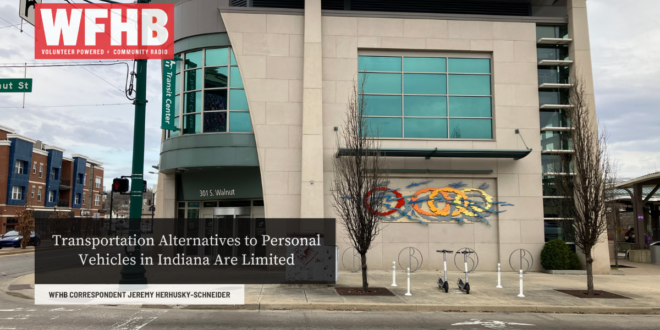Podcast: Play in new window | Download (Duration: 11:18 — 15.6MB)
Subscribe: RSS
By Jeremy Herhusky-Schneider
Public, equitable and sustainable transportation alternatives to personal vehicles in Indiana are limited. Attempts to increase public transportation in 2014 led to the banning of light rail in several Indiana counties. Although the ban was supposed to be repealed with the 2019 House Bill 1365, the House Bill died thus keeping the ban in place. More recently, this year’s legislative session heard Senate Bill 52 which would prohibit use of dedicated transit lanes (a bill targeting the Indianapolis bus Blue line). The ban to prohibit dedicated bus lanes was dropped but the possibility to limit the amount of lanes is pending.
Indiana’s state government and municipalities need to keep its options open because personal vehicles as the primary transportation system have several issues, according to Dr. Yonah Freemark of the Urban Institute.
“I basically was just convinced that when we think about transportation, it fundamentally is about connecting people from one place to another. And without understanding exactly what causes people to be located adjacent to transportation options, or vice versa,” Freemark said.
However, transportation is not an isolated issue. According to Freemark, we need to consider land use and zoning laws.
“Zoning that allows for only low-density development or that separates housing from jobs can lead to higher transportation cost burdens,” said Freemark in “Cracking the Zoning Code.”
As to why these issues are not being addressed, Freemark and the Urban Institute’s research has led them to review the folks that make these decisions in the following paper, “Who Makes Planning Choices” which found that “… on average, board membership is an overrepresentation of non-Hispanic white people, men, homeowners, and people whose occupations are in the planning and development sectors.” The paper concludes that this is a cause for concern because “If people who are Hispanic, women, or renters—or who hold occupations outside of the development sector—are systematically excluded from decision making roles, one key element of local government polity is in the hands of a group of people who do not adequately reflect the residents of these communities. It is possible, even likely, that the decisions being made about land-use policy do not serve the interests of underrepresented groups. This, in turn, may be one explanation for the inequitable outcomes we have historically seen in planning policy in the United States.”
Even small municipalities like Bloomington, according to former city council member Steve Volan, should consider how it zones and builds and grows corridors of businesses and homes with a priority on dense mixed use developments.
“But I think the key to it is transit oriented development. So what does that mean? It means that you develop new housing and commerce nodes that are dense enough that it justifies running a bus to it,” Volan said.
Although Bloomington is not large enough for a light rail system to be feasible, Dr. Freemark suggests.
“I do think that that improvements on bus service are probably the most effective thing for communities with, you know, relatively small populations. I think the goal here is really to encourage substantial investment in in those bus lanes to make sure that they are, you know, giving people the option to get around frequently, reliably and quickly,” Freemark said.
Volan looks forward to developing a bus system or rapid bus lanes around populated corridors by working with the county. One recommendation by Steve Volan is:
“What can we do to develop around transit to get developers to think I don’t need to build as much garage space or parking space or its street width, I can put more units on there. And I can generate more money and build the denser development that people are demanding. If I just don’t assume that I have to accommodate the car everywhere, and if they build densely enough, then it justifies running a bus to it,” Volan said.
Although a future with more public transportation will be equitable and sustainable, projects are often opposed or banned because of cost. Steve Volan argues the following:
“We don’t really think about how much the overall cost of accommodating cars costs us because it doesn’t come out of one pot, you’ve got the street budget over here, you’ve got the cost of structure parking over there, you’ve got the cost of land that you have to acquire in order to meet minimum parking requirements. All of those things add up, but nobody adds them up,” Volan said.
Dr. Freemark also agrees and does not buy the cost argument against public transportation projects:
“We spend way way more on investments in you know private cars and maintenance of those cars and the environmental impacts of those cars,” Freemark said.
Some organizations have attempted to measure the financial impact of car dependent transit systems, like Strong Towns.
Although public transportation is limited in Indiana and Bloomington, Volan imagines a future with trains.
“I met Herman Wells back in 1990…he told me that as an undergraduate in the early 1920s, he could get from Bloomington to Chicago in five hours by electric interurban rail. Five hours, it takes me four hours to drive to Chicago, when there’s no traffic, and the idea that I could sit and read a book or do work on a train to Chicago breaks my little heart that Indiana was crisscrossed by trains,” Volan said.
However, state legislative attempts to ban public transportation options will not make futures like this possible.
 WFHB Bloomington Community Radio
WFHB Bloomington Community Radio


